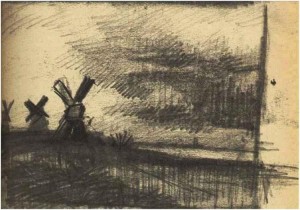Little is known about Vincent van Gogh’s schooling. His sister, Elizabeth, 6 years his junior, did not remember much about his schooling and what little she did recall has been found incorrect. Jo van Gogh-Bonger did not know much about Vincent’s schooling either, what she did know was likely learned from her mother-in-law.
Vincent van Gogh was born in Zundert, a village in Brabant, in the south of the Netherlands, where his father, Theodorus van Gogh, was the minister of the Protestant parish. This is where his education began. In 1861 Vincent van Gogh began his schooling at the school in the village where 1 teacher taught roughly 200 pupils. However, his parents found that he was growing too rough while daily keeping company with village peasant boys. His parents instead, sought a governess to teach the six Van Gogh children at the parsonage.
On October 1, 1864, at the age of 11, Van Gogh’s parents sent him to Jan Provily’s boarding school in Zevenbergen, about 20 miles from Zundert. He stayed at the boarding school until early 1866 when he was prepared to advance to secondary school. His parents chose to send him to the newly opened state sponsored, Rijks Hogere Burgerschool “Willem II” (State Secondary School King Willem II) in Tilburg. The school was located in the building that had once been the palace of the late King Willem II. The building had been donated to the municipality of Tilburg by members of the Dutch royal family and when the renovated school opened in 1866 Van Gogh was a member of the first class of students.
Run by the government, the school offered good salaries and was staffed with nine qualified teachers. In September 1866 there were 36 students at the school. The school did not board the students so boarding had to be found for Vincent. Van Gogh was placed with J. Hannik, his wife and their son, a boy five years older than Vincent.
The school had a preparatory class but Van Gogh was immediately placed in the first class (7th grade) because he had received an excellent primary training. The weekly schedule at the school was rigorous: Dutch and German 3 hours per week, French and English 5 hours, arithmetic, history and geography each 3 hours a week, geometry and linear drawing 1 hour a week, free-hand drawing 4 hours per week, botany, zoology, calligraphy, and gymnastics 2 hours a week each. 
The unusually large amount of time spent on free-hand drawing was directed by Cornelius C. Huysmans, a renowned national figure and arts educator. Huysmans was a pioneer in the Dutch arts reform.
Following exams, in July of 1867, Van Gogh and 4 other students were promoted to the second class, while 5 others were retained. This is an indication that Van Gogh was an intelligent boy.
Van Gogh didn’t finish the second school term. In March of 1868, a few months before the academic year ended, he abruptly left school and returned to Zundert. It is unclear why he left school but this was the end of this formal education.
